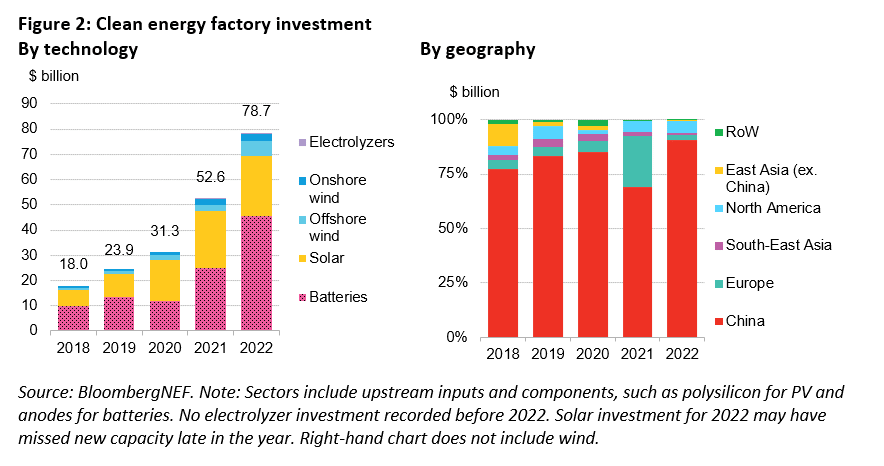Global low-carbon or clean energy transition investment jumped 31% in 2022 with a total of $1.1 trillion, drawing level with capital for fossil fuels, according to BloombergNEF report.
Both figures broke new records in global investment in the clean energy transition. These “firsts” are driven by the energy crisis that hit the world last year as well as policy actions that enable the deployment of clean energy technologies much faster.
The research firm accounts each year how much money companies, financial firms, governments, and individuals invest in low-carbon energy transition. BNEF reports the results in its Energy Transition Investment Trends.
Setting New Record: Investment by Sector
There are 8 sectors covered in the report including:
- Renewable energy
- Energy storage
- Electrified transport
- Electrified heat
- Carbon capture and storage (CCS)
- Hydrogen
- Nuclear power
- Sustainable materials
Out of those eight, only investment in the nuclear power sector didn’t set a new record as it stays almost flat. While the rest reached a new record investment level.
The sector that got the highest investment share is renewable energy – wind, solar, biofuels, and others. It set a record of $495 billion committed in 2022, up 17% from 2021.
Remarkably, the electrified transport sector (investment in electric vehicles) is almost at par with renewables. The sector received a 54% increase from prior year – $466 billion.
The least achiever is the hydrogen sector, getting only $1.1 billion which represents 0.1% of the total investment. Yet, given the growing interest and strong policy support in the sector, hydrogen is the fastest-growing. It attracted an investment of more than 3x in 2022.
In fact, government subsidy programs this year will help ensure that the global green hydrogen industry will turn into a large-scale renewable power source.
In the U.S., the Inflation Reduction Act offers tax credits to clean hydrogen producers. The second largest emitter has an $8-billion program that will fund regional clean hydrogen hubs in the country.
Other similar programs also exist in the EU, UK, Germany, Canada, India, and China. Their common goal is to promote clean hydrogen industry.
When it comes to clean energy investment share by country, China takes the lead. The largest emitter got almost half of the global total investment in low-carbon energy transition, bagging $546 billion.
The U.S. took the second slot with $141 billion while Germany secured the 3rd place, again. France took over the UK’s previous 4th slot as the latter fell down to 5th place.
Closing the Investment Gap: Clean Energy vs. Fossil Fuels
BNEF also reported estimates on global investment in fossil fuels. The figures include every aspect, from top to bottom, of fossil power generation.
- For the first time, the total estimated amount poured into fossil fuels exactly matches that of the clean energy transition – $1.1 trillion.
Last year, large banks favored fossil fuel financing over decarbonization goals. Three of them have invested a total of $789 billion into fossil fuels from 2016 to 2021, and $199 billion was for 2021 alone.
The new report stirs attention as it seems to turn the tide in global investments. And despite the energy crisis last year, the transition to clean energy appears to catch more eyes.
According to the Head of Global Analysis at BNEF, Albert Cheung, instead of slowing down, “energy transition investment has surged to a new record as countries and businesses continue to execute on transition plans.” He added that:
“Investment in clean energy technologies is on the brink of overtaking fossil fuel investments, and won’t look back. These investments will drive short-term job creation and help to address medium-term energy security objectives. But much more investment is needed to get on track for net zero in the long term.”
Indeed, under BNEF’s 2050 Net Zero Scenario, the world needs an annual investment on energy transition of $4.55 trillion in this decade. It means the 2022 achievement must triple and more to tackle climate change.
One notable area that’s part of the $1.1 trillion investment is climate-tech corporate finance. It involves new equity financing raised by climate-tech companies, which is down 29% from 2021.
2022 was not a good year for global equity markets as the report noted. Still, venture capital and private equity funding went up 3%.
Clean Energy Factory Investment
BloombergNEF’s report also shows how much goes to manufacturing facilities for clean energy. The amount went up from $52.6 billion in 2021 to $78.7 billion in 2022.
As the chart below indicates, facilities for batteries got the biggest share worth $45.4 billion. Solar factories came next with $23.9 billion investment.
-
BNEF’s figures only account for successfully commissioned factory projects.
By geography, China remained at the top in manufacturing investments last year – 91%! And that’s despite huge efforts from other nations to attract low-carbon energy investors.
In the US, for instance, there were a series of commitments for new or expanded clean energy factories in the past months. They’re not, however, included in the report.
Looking forward, the research firm said that between 2023 and 2026, clean energy factory investment only needs an annual average of $35 billion to meet the Net Zero Scenario.
In other words, “manufacturing capacity for clean energy technologies is unlikely to be the major bottleneck to achieving net zero”, said BNEF’s Head of Trade and Supply Chains research.



